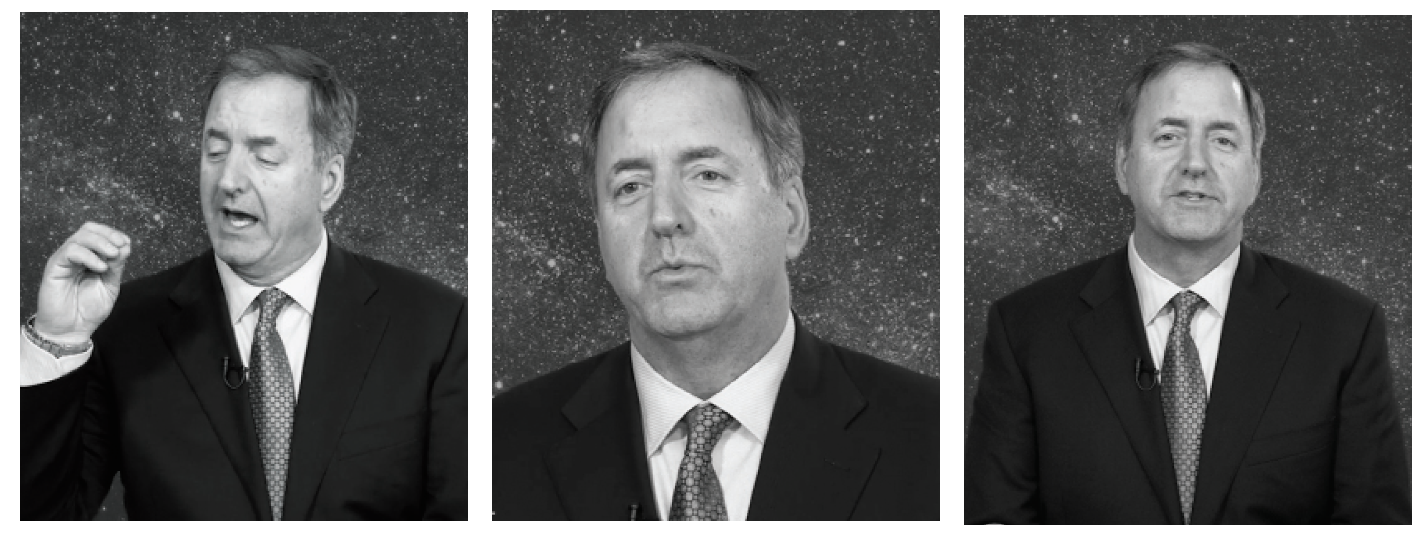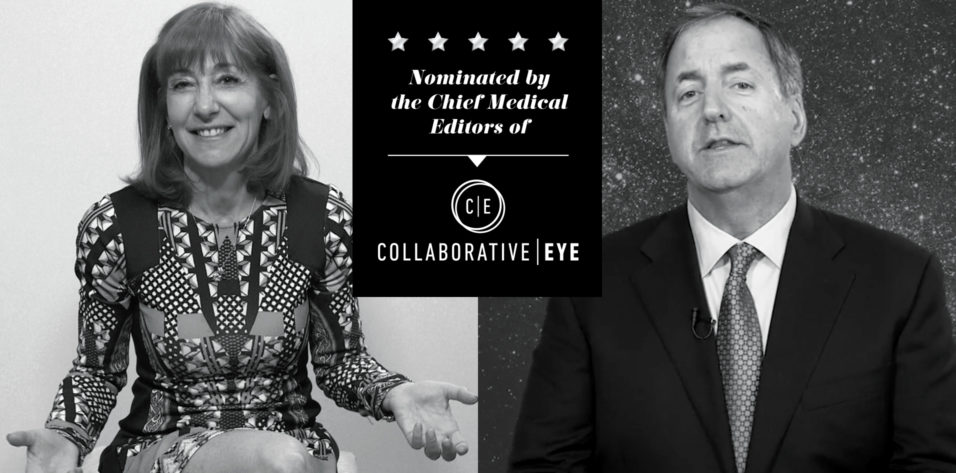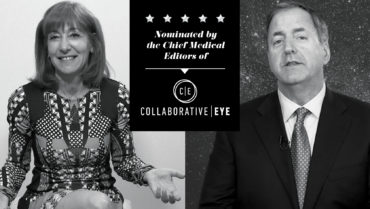Dr. Black is a well-known international speaker and author and an early participant in collaborative care alongside Jeffery J. Machat, MD, FRCSC, DABO. In this interview, Dr. Black talks about her career decision in grade 13, how she came to meet Dr. Machat as his patient, and how their collaborative partnership has developed over the years.
Interviewed by Scott Krzywonos, Editor-in-Chief, CollaborativeEYE

BMC: At what point in your life did you decide to pursue a career in eye care?
Sondra Black, OD: I have one of those stories that isn’t the traditional I’ve-wanted-to-do-this-since-I-was-a-child story. But the story is simple: When I was in grade 13 (yes, we have grade 13 in Canada), I told my closest friend that I had no idea what I wanted to do. He told me he was going to the University of Waterloo to become an optometrist. And I said, “Okay, I think I’m going to come with you.” Honest to God, that’s how it came about.
BMC: When did you begin to realize that you had an aptitude for eye care?
Black: I had classmates who did way better than I did academically, but they couldn’t talk to patients. Our clinician-preceptors weren’t happy with their performance, and that’s where I excelled. That’s when I realized that I was in the right field.
BMC: When did you first start collaborating with surgeons?
Black: I had a private practice for 20 years, and, 18 years into it, I decided to undergo LASIK. I did a lot of research. I went to all the clinics in the city, and I sat in on a lecture at TLC Laser Eye Centers given by Jeff. After listening to him I said, “Okay, he’s going to be my surgeon.”
I began to tell my patients about this life-changing event, and, after hearing it from their primary eye care provider, they decided that they wanted LASIK for themselves. I was referring about a dozen patients per month to Jeff’s practice.
BMC: Was that a lot of patients at the time?
Black: I was among his top referrers, for sure. And I took an extra step by making sure I was present with my patients during their surgery. Jeff noticed that things flowed more smoothly when I was there. He called me one day and said, “Sondra, you’re taking too much time out of your practice to be here, but I don’t want you to step away. Let’s change things around a little bit.”
BMC: What did you work out?
Black: At first, Jeff scheduled all of my patients on the same day of the month. This way, I could make a single visit for a half day per month and still be with all of my patients. And he gave me the tools—a pachymeter, a topographer—to do complete preoperative workups in my own office.
BMC: So you were never in the same office?
Black: Not at first. But when the first custom LASIK procedures were about to be done in Canada, Jeff asked if we could start working together 2 days a week. In March 2000, I worked up 135 patients for custom procedures, and he operated on every one of them. After that, we knew we needed to work together full time.
BMC: How many other practices had a surgeon-optometrist relationship like yours?
Black: No one else was doing this in the early days except for TLC. I credit Jeff, really, as the innovator for comanagement.
BMC: Did you encounter any resistance to this model?
Black: Oh, sure. Jeff in particular encountered ophthalmologists who did not think that working with optometrists was the right way to go, that ODs and surgeons were in competition. In reality, we really are specializing in different parts of eye care. And we do much better when we work together. I was lucky because Jeff was the cofounder of TLC, which embraced the comanagement model from the start.
BMC: What advice would you give to your 25-year-old self?
Black: I would tell myself that it is extremely important that optometry adopt a medical model. Optometrists who think that they can do right by their patients by not giving them surgical refractive options and only performing annual eye exams are doing a disservice to their patients.
I would also tell myself that patients must understand all of the options that are available to them, whether for refractive or intraocular surgery. Optometry should ensure that the ocular surface is healthy before making a surgical referral, and all relevant information about the patient should be passed along to the surgeon. And I would tell myself to work with a surgeon who thinks like I do.
BMC: If you had to nominate one creative mind in ophthalmology, whom would it be and why?
Black: I’ve said his name plenty of times already: Jeff Machat, the surgeon who hired me. He really did start the whole concept of comanagement. He changed the face of ophthalmology and optometry.
Dr. Thompson, who has been a leader and researcher in the development of many advanced refractive and cataract surgery technologies, is the founder of Vance Thompson Vision. The surgical practice with three locations in three states (South Dakota, North Dakota, and Montana) is known for the white-glove service it offers patients. In this interview, Dr. Thompson talks about rock music documentaries, his fascination with greatness, and morning huddles.
Interviewed by Scott KrzYwonos, Editor-in-Chief, CollaborativeEYE

BMC: Who or what drew you to ophthalmology?
Vance Thompson, MD, FACS: My dad and grandpa were both small-town family doctors in South Dakota. I thought I would be a family doctor, too. My friend in medical school, Peter Sneed, MD, would tell me about his father, who was an ophthalmologist. Peter is the one who planted that seed in my mind. I also spent time with John Willcockson, MD, during medical school. It just blew me away—the microsurgery and the idea of restoring vision.
I’ll never forget telling my dad, that Christmas during my junior year in medical school, “I am not going to be a family doctor. I think I’m going to be an eye surgeon.” I remember him saying, “So, which eye are you going to specialize in?” He was eventually very proud of me, but in the beginning that family-doctor-versus-specialist thing kind of showed.
BMC: Who did you interact with when beginning your education?
Thompson: I spent time with Jeffrey Hottman, MD, during medical school. When it came time for fellowships, I was fascinated with the anterior segment, and Jeff told me about his fellowship with Daniel S. Durrie, MD. He encouraged me to apply for that fellowship. I was accepted and was asked to help organize a study as soon as I arrived. That got me started in refractive surgery and research and development.
Dan was my mentor, and his ability to, at every stage of his career, have such passionate curiosity and enthusiasm—almost a childlike enthusiasm—to solve problems really lit a fire in me. This July will be 28 years since he first lit that fire, and it has continued to burn throughout my career.
BMC: Did any of this influence your feelings toward collaborative eye care?
Thompson: My time in Dan’s fellowship catapulted my research career and exposed me to working with optometry. It taught me a lot about the value of relationships with referring doctors. And so, when I came back home in 1991, I was excited to deliver refractive and cataract surgery and to collaborate with optometry and build a referral network. Probably the most impactful step I took was asking an optometrist to join me in practice. And he’s been with me almost my whole career. That’s Doug Wallin, OD, who had done similar training in refractive and cataract surgery and pre- and postoperative care with Richard Baker, OD; Stephen G. Slade, MD; and Ralph Berkeley, MD, when they were all together in Houston.
BMC: It seems that you value teamwork. How did you form your team?
Thompson: Well, I think it goes to the core of what I want: I want to serve my fellow man well. I guess it’s a passion to please, or a passion to serve. That applies to everyone—the people I work with, the patients I see, and the referring doctors who collaborate with me. It comes down to hard work, creative thinking, and being fascinated with the journey. I don’t know if this is an appropriate place to talk about this, but I’m fascinated with rock music documentaries.
BMC: What about them do you find fascinating?
Thompson: They show how the sum is greater than the parts, and how rare it is for members of a rock and roll group who made beautiful music together to break up and achieve the same success apart. I think about that when thinking about teams. I happen to be fascinated with greatness, and working with people who are great inspires me.
I’m a drummer. I am fascinated with great drumming. I’m not that good at drumming, but I know enough about it that I can recognize greatness. When you see Yo-Yo Ma play his cello, you get this feeling in you that recognizes—and is amazed with—greatness. I can get that same feeling in a meeting with my team when we’re trying to answer a complex question. When I hear a unique idea and recognize it, there’s joy and excitement in recognizing it. One of my favorite things is drafting the right people for a team that will create a masterpiece.
BMC: How do you decide whom to draft?
Thompson: People who enjoy being around each other. Problem-solving often takes time. Frustrations and ups and downs occur, and the only way to get to your goal is if, at the core of it, you enjoy working together. I also want people who are attracted to the creative process, people who are willing to roll up their sleeves and get to work, and people with a basic belief in people and teams. Those who prefer routines and want a punch-in/punch-out lifestyle are not going to fit.
BMC: What’s the role of the surgeon in educating the patient, and what’s the role of the optometrist?
Thompson: It’s so important that patients understand the basics of—and the risks and benefits of—a surgical procedure. It falls on eye care providers to review technology options; this responsibility has grown more complex as the number of technologies has grown.
I’ll use premium cataract surgery as an example. Cataract surgery is such a commonly performed procedure that it’s easy to fall into a routine of not spending enough time talking about the implant options. These implants have been innovated in amazing ways, and our patients really appreciate it when we take the time to explain the advantages and disadvantages of monofocality, multifocality, extended depth of focus, and accommodating lenses. It helps so much if the optometrist and the surgeon are both educating on these options, so that the patient can participate in the decision-making process of a lifelong choice.
The majority of patients in this country are seen by optometrists first, and I always tell patients, “You want to talk to the provider who has taken care of you for years and get their opinion. That’s who you built your trust with.” I also tell them that they should do some internet research on the type of lens they want. I warn them that some of what they’ll find on the internet is unreliable, but that a surgical practice such as ours can help them to understand what we believe is real and what’s not real.
BMC: It sounds like you think that collaboration is key.
Thompson: The collaborative part is just so important. There are so many patients in need, and optometry and ophthalmology need to create a powerful one-two punch to provide the best surgical care and education for the patient. Optometrists and ophthalmologists must read the literature and trade publications and attend conferences so that they can bring their A game to educating a patient on what they would do if it was their eyes or the eyes of their family member.
Consider a 40-year-old cataract patient whose disease has affected her nighttime driving, but she is still satisfied with her computer and morning make-up applying vision. If such a patient is uneducated about the options, she will be fit with a monofocal IOL. Then she shows up in the surgeon’s office postoperatively, unhappy because she went from the accommodation of a 40-year-old to the accommodation of a 70-year-old because absolute presbyopia was induced by the monofocal implant. The patient never learned about multifocality or extended depth of focus IOLs, and she is frustrated. That’s what we’re trying to prevent.
BMC: Then the MD and the OD really need to be on the same page when it comes to education, correct?
Thompson: Yes, but we can’t forget about the staff. To me, staff members are part of the education team. When we use the phrase the optometrist and the ophthalmologist, we’re really talking about the clinic as a whole—the entire team. It’s important to educate the team about how the doctor thinks because patients spend a significant amount of their time with staff members. A well-educated staff member can do so much to optimize not only patient education but also the patient experience.
Our team does a huddle every morning. We talk about something educational or experiential. We record the huddle and offer it to team members who were unable to be there that morning. We encourage everybody to watch that video. Then a couple times a year we shut down our center and have retreats with our team to educate them on what we do so we can all keep up with the advancements that are happening at an amazing pace.
BMC: If you had to nominate one creative mind in ophthalmology, whom would it be and why?
Thompson: You’re already profiling him in this series, but I would say my partner, whom I share an office with everyday, John P. Berdahl, MD. He uses his creativity to solve problems big and small—and does it with such zeal that it’s fun to watch. (Editor’s Note: The Chief Medical Editors of MillennialEYE have selected Dr. Berdahl as one of its creative minds.)
Let me use the example of an invention that I have had a front row seat to watch the birth of the idea and the development of the technology: Balance Goggles. The goggles are used to control atmospheric pressure around the eye, to treat glaucoma on earth (and zero gravity ocular complications in outer space). John theorized that two pressures play a role in glaucoma: IOP and cerebrospinal fluid (CSF) pressure and did the research to prove this. In the early stages of joining our practice, John was searching for ways to address IOP, and he asked me to ping pong ideas with him. These brainstorming sessions ultimately led to the creation of Balance Goggles. To watch his brilliant mind in action and how he came to the conclusion of the goggles was fascinating to me. I have performed a lot of research over the years and have been involved in many FDA-monitored trials and brainstorming sessions, and I have to say that the goggle journey with John ranks as one of the most exciting technologies I have ever had the honor to be a part of. The creative process required to arrive at the final concept was a blast.
Excellence and creativity fascinate me; therefore, John fascinates me. Problem solving permeates every aspect of his life—whether it is related to the first noninvasive titratable goggles to treat glaucoma on earth and help outer space ocular therapy or optimizing the patient experience in our office. He enjoys trying to make a great thing even better and, wow, that makes for a fun partnership.


